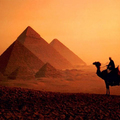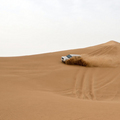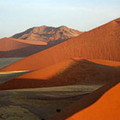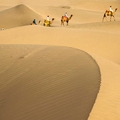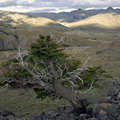Eco-friendly locations / The Largest Deserts in the World / The Sahara Desert, North Africa
The Sahara Desert, North Africa
The Sahara is the largest desert in the world. Its area is more than 9 million square kilometers. It covers almost the whole of North Africa: Egypt, Tunisia, Morocco, Mauritania, Niger, Sudan, Libya, Algeria, etc. In fact, the Sahara Desert is 30% of the entire African continent. This is the hottest hot spot in the world with summer temperatures often exceeding 57 degrees Celsius. In summer the temperature is above 33 ° C, in winter, it is usually kept within 15-28 ° C, especially hot in the daytime is in Libya were reported temperature rises to 58 ° C. This area is characterized by strong winds, they are able to move the sandy dust even in the Atlantic and on the European continent.
History
Sahara, the greatest desert on the Earth has 7 million square km 2. The Sahara desert was already in prehistoric times. However, in the history of the Sahara encountered times when it was covered with grassland or forest. At the last glacial period the climate was wetter in Sahara, than now. It is assumed that it was over heated, covered with gravel, rushing storms, throwing in the face of quartz sand, fifty or a hundred thousand years ago there were extensive shallow muddy lakes, which were surrounded by reeds and water lilies. Fish splashing in the warm water, and in the coastal thickets of mimosa hid various animals resembling wild animals in tropical Africa today. But when the heat and the lack of water became unbearable, the man and the animal left the desert. Throughout the desert were found a variety of tools used by the old man in the Paleolithic era. The most difficult challenge when traveling across the Sahara could be the sand or the dust storm, in which the scorching wind powerfully lifts a heap of dust and sand to heaven. There is no secret that there can be more than 150 thousand mirages to watch in the desert. There are some maps for the caravans, which represent the most likely locations of a mirage, and even specify what kind of mirage can be seen in a particular place - an oasis, a well or a palm tree. Today you can get quite simple to the Sahara or in any city on the North Coast of Africa. For example, from Algeria to the south. There is a decent highway, which will take about a day's journey. The Sahara is a constantly changing desert under the influence of perpetual winds, the wind carries hundreds of billions of grains of sand from one place to another, in some cases, the sand can be found in almost every region of the Earth.
Sahara for tourists
Tourists may happen to see beautiful landscapes here, which are low pieces of rock, oddly changed over the time under the influence of the sand and the wind. In general, the surface of the desert comprises sand dunes (ergs or), as well as clay and rocky areas. Archaeological excavations indicate that earlier the Sahara desert was a more humid terrain with magnificent savannas, which nowadays can be found only in the Tibesti and Darfur. The rest of the desert is contented with occasional rainfall, the size of which is barely a year, 250 mm in the northern territory. In the south their number is much lower, about 25 mm. There are dry periods, lasting up to three years, during which there is no precipitation at all. The only surface of water source in the Sahara is the Nile river, which crosses it on the east. Due to the presence of groundwater in an arid desert, it is possible to use deep wells to provide moisture and oases of cultivation in these dates, olives and grapes. The most memorable experience for guests of the Sahara will be the setting of the sun in a quiet, sunny weather! The amazing range of colors magically shimmer, shine, cover the entire sky and slowly begins to fade. At the same time over the desert suddenly comes complete darkness, coming to replace the indescribable riot of the colors of the sunset!
Others The Largest Deserts in the World .
Maps of The Sahara Desert, North Africa
map AlgeriaOthers from The Largest Deserts in the World
Under such dry conditions it is hard for the plants to live and the soils to form.
There is anything that protects the earth from overheating in these areas.
The hottest place on the Earth is the tropical desert, but there are coldest , even icy deserts, for instance, Antarctica.
Deserts cover approximately 20% of the Earth's land surface and 80% in Australia , therefore, a fifth of the Earth's land area belongs to the deserts.
Many of the major deserts are located near the tropics, such as the Sahara desert which is the largest desert in the world, as well as the Kalahari, the Namib Desert and the Grand Victoria in Australia.
Droughts During the grazing of cattle during droughts disorders of vegetation occur.
They are so significant that are likely unrecovered.
The sun's rays quickly dry the soil and turn to dust, which happens to desertification, a continuous transformation of the land in the desert.
A desert with a change in climatic conditions can always shrink and expand.
The long-term global climate change or contraction of the continents can garden the desert or turn it into a magnificent forest.
Short-lived changes in weather conditions influence the expansion of its borders, turning occasionally green areas in arid deserts.
The hottest places on the Earth are the tropical desert, where the daytime temperatures often reach +50 ° C.
This heat can destroy the stones and give the landscape an unusual character.
The underground water evaporates so quickly that minerals are dissolved from the crust.
Deserts are constantly dry, but in other natural areas prolonged dry periods can occur - the droughts.
Their presence in any place depends on what kind of rainfall is there.
There was a drought in Sahel, Africa, that lasted many months without rain.
However, droughts are regular and in some places they are with a typical moisture content, such as the North American grasslands which dry up every 22 years.
Water plays a significant role in shaping the dry landscape, despite of its low quantity in the desert .
Water alters the chemical composition of rocks, now and then it is dumped in the desert from the sky, at times becoming the cause of short, but strong flash floods, which are harmful to the soil.
Do all the deserts have very high temperatures and a lot of sand? We call a desert an area where not more than 25 inches of rain falls per year.
As a rule, deserts are formed in the hot desert climates, but there are exceptions.
Most deserts have a lot of rocks and stones and sand.
What is the biggest desert? The most extensive deserts are located in areas of high atmospheric pressures.
All the winds blow in areas of their inner regions, but the moist winds from the sea reach them very rarely.
There are those deserts, which are near the sea, and yet the sea winds will reach them, they lose most of moisture on the way.
Certain deserts are formed on the internal continental slopes of mountain ranges, well sheltered from the sea winds.
Almost all of Antarctica is a huge frozen desert, which is located in an area of high pressure, so that its interior is extremely small drops of fresh snow.
The driest desert in the world.
In many deserts there is no rain for several years in a row, then a short downpour happens and everything starts all over again.
The most arid desert is the Atacama Desert in South America .
Until 1971, there were 400 years without spilling a drop.
It is known that in several places in the desert, there are artesian waters, but the high boron content makes them unsuitable for irrigation.
What is an oasis? An oasis is a plot of land in the desert, which is covered with vegetation.
It feeds from underground springs or natural wells.
The largest desert in the world The largest desert in the world is the Sahara Desert in North Africa.
Its area is of approximately 8400 sq.
km.
However, only ten percent of its territory is covered with sand, and everything else is taken by bare rocks and stones.
After Sahara, we have the Arabian desert, the Gobi, the Patagonian,the Rub’ al Khali, the Great Victoria, the Kalahari, the Great Basin, the Chihuahuan and the Thar.

